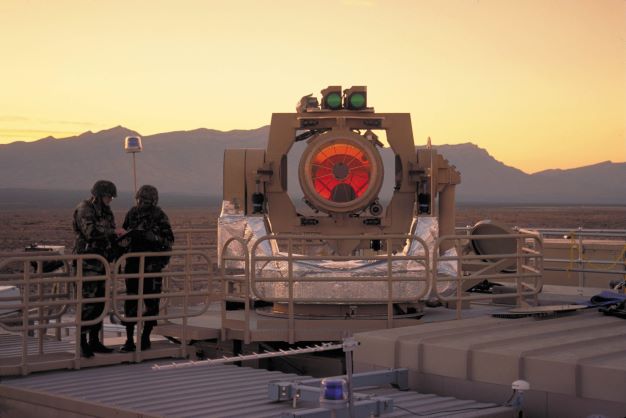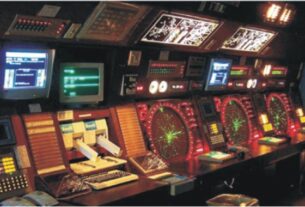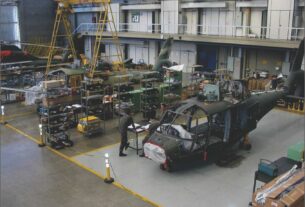The ancient art of warfare has now evolved into a sophisticated battlefield strategy based on the large scale use of fighting platforms and combat equipment stuffed with advanced electronic systems and devices capable of “seeing and sensing devices” beyond the “visual range”.
Clearly and apparently, Electronics Warfare (EW) paves way for enhanced situational awareness and information dominance to stay ahead of the adversary in the thick of the battlefield. Basically EW strategy revolves round the exploitation of electromagnetic spectrum or directed energy to control and manipulate the spectrum and take enemy by surprise.
On another front, EW also focuses on limiting and impeding the access of adversaries to the potentials of spectrum. As it is, EW has been defined as an integrated and composite defensive and offensive strategy based on the exploitation of electromagnetic energy to detect, exploit, minimize or obviate the use of electromagnetic spectrum by the adversaries.
EW platforms can be based in air, land, sea and space and could be both manned and unmanned devices. As it is, the mastery of EW operations is also critical for the successful implementation of the network centric warfare strategy. Further, EW is also crucial to exploit the full potentials of an aerospace command.
Potential of EW
The daring accomplishment of Naval SEALs of the US National Special Warfare Development Group that led to the assassination of the most dreaded terrorist Osama Bin Laden in the town of Abbottabad in May 2011 stands out as a tribute to the marvels of EW. For the air raid involving a well equipped helicopter used for this mission was launched from the neighbouring Afghanistan. That this helicopter was able to successfully evade the detection of the ground based radars in Pakistan and zero in on the target speaks volume for its robust stealth features.
As it is, stealth operations are a vital component of EW strategy. Similarly, the potentials of EW in realizing the strategic goals speedily and affordably was convincingly developed by the sustained deployment by the Central Intelligence Agency (CIA) of remotely operated, weaponized drones endowed with the faculties of intelligence and automation to pound the safe sanctuaries of radical groups and Taliban militia in the difficult to access mountainous stretches spread across Pakistan and Afghanistan.
In the ultimate analysis, the key ingredients of a successful EW strategy include automation, intelligence stealth, remote manipulation and unmanned surveillance. The expanding frontiers of EW also draw heavily from the potentials of satellites, communications and information networks which pave way for the smooth integration of fighting platforms, command centres and defence forces spread around the world.
The Hyderabad based Defence Electronics Research Laboratory (DLRL) of the Defence Research and Development Organisation (DRDO) is involved in the development of integrated electronic warfare systems for the Indian armed forces. Its primary responsibility includes the design and development of state of the art electronic warfare systems covering radar and communications frequency ranges.
India’s EW efforts
By all means, the development of Weapon Locating Radar (WLR) by the Bangalore based Electronics and Radar Development Establishment (LRDE) of DRDO is a major boost to the EW efforts of the Indian defence forces. In addition to locating hostile artillery/mortar units and rocket launchers, WLR is capable of detecting projectiles with small cross sections across the battle space horizon. Further, it can handle simultaneous fire from weapons found in a variety of locations.
To expedite the development and qualification of radar based electronics warfare systems, DRDO has set up two new sophisticated test ranges-one at Chitradurga in Karnataka and the other at Tandur in Andhra Pradesh. Radar based sophisticated communication systems would use electromagnetic spectrum for attack, protection and warfare support to destroy the combat capabilities of the enemy.
It is in the fitness of things that DLRL and DARE (Defence Avionics Research Establishment) are focussing on the development of fourth generation EW Systems. According to former Indian President and a globally acknowledged defence and space scientist Dr APJ Abdul Kalam, “The electronics warfare system is a force multiplier which needs a high level of secrecy for maintaining surprise against adversary actions. In such a situation, it is essential that the system design, architecture and deployment knowledge is generated within the country and maintained as a closely guarded information by services. This is essential to ensure tactical and strategic advantages for our armed forces during an operation”.
Even as India lags behind US and China in the area of EW, efforts are nonetheless on to design and develop systems and combat platforms meant to take India’s capability in EW to the next level of sophistication.
For instance, Samyukta mobile electronics warfare system developed jointly by DRDO, BEL, and ECIL (Electronics Corporation of India Limited) as well as the Corps of Signals of the Indian Army is well suited for tactical battlefield use. It covers a wide range of frequencies and coverage in electronics spectrum is handled by the communications segment and non communications segment. Clearly and apparently, it has both electronic intelligence and communications intelligence capabilities built into it.
Obviously, Samyukta, the development of which was supported by over 40 Indian micro, small and medium industries, could very well serve as a test bed for developing futuristic EW systems of varying specifications. The system is composed of 400 individual entities and has the built in capability for surveillance, interception, monitoring, analysis, recording, location fixing and jamming of all communication and radar systems.
On the other hand, Mayavi electronic warfare suite designed and developed by DARE and BEL used in combat aircraft has many advantageous features. Mayavi is designed to enhance survivability during deep penetration and actual combat. Mayavi includes a radar warning receiver, missile approach warning system, laser warning receiver system and infra red ultraviolet missile warning sensor as well as self protection jammer, chaff, jaff and flares, electronics counter measure suite and a towed radar decoy.
DARE has also successfully equipped a range of fighter aircraft in service with the Indian Air Force (IAF) and warships with the Indian Navy with a variety of electronic armours composed of electronic support measures and self protection jammer. Indeed, DARE has made significant contribution to the area of air borne electronic warfare. The electronic warfare wing of DARE primarily focuses on the design and development of radar warning systems and warfare suites for a variety of fighter aircraft, military transport aircraft and helicopters with a view to enhance their survivability and mission accomplishment.
Directed energy weapons
RF (Radio Frequency) weapons have the potentials to persistently disrupt or damage the combat equipment liberally stuffed with electronics devices. Against this backdrop Directed Energy Weapons (DEW) which generates a beam of concentrated electromagnetic energy to irradiate and destroy targets could very well become the future of EW. Of course, right at the moment, DEWs are long way off from being fit enough for deployment in the battlefield. Significantly, the positive features of DEW include controlled lethality, cost effectiveness, high speed, ability to counter moving targets and precision engagement. By all means, DEW can very well herald revolutionary changes in the way the war is fought.
DEWs can be based on lasers, high powered microwaves and particle beams. Though considerable ground work has been done in the areas of lasers, high power microwaves and other directed energy technologies, development of weapons continues to pose a stiff challenge. There is no denying the fact that the nascent technology of DEW will revolutionize many aspects of modern warfare.
As part of its long term plan of putting in place a range of high performance futuristic battlefield systems based on cutting edge technologies, DRDO is focussing on realizing operational DEWs. As part of this vision, DRDO has on hand a project to develop a high energy laser beam weapon capable of destroying an incoming enemy missile. If all goes well then DRDO would develop a laser system based on solid state device that would be capable of generating a power of 25-kW to shoot down a missile during its terminal phase at a distance of 5-7 km.
Developing a laser system of this magnitude poses a serious challenge since at this point of time, the country lacks the expertise and knowhow required to produce a laser beam capable generating just a couple of kilo watts of power. Of course, under the Aditya Technology demonstrator project DRDO would work on gas dynamic laser and chemical laser technology. Ultimately, DRDO should be able to achieve a breakthrough in realizing a compact, solid state laser device capable of shooting down a missile.
Indeed, whether it is unmanned aerial vehicles, new ammunition and missiles or spectral surveillance and dominance, increasing reliance on high performance electronics devices has become the order of the day.
Significantly the Bangalore based India Product Development Centre of the US based Analog Devices has developed a range of cutting edge systems to support various aspects of EW. Analog Devices has made its products available to the variety of UAV systems being developed in India.
Use of satellites
By all means, high performance satellites meant for a variety of end use could be a major game changer for the Indian defence forces keen on boosting their EW fighting capability. Indeed, the successful launch of IRNSS-1C satellite constituting a part of the seven spacecraft IRNSS (Indian Regional Navigation Satellite System) constellation in October this year could help Indian defence forces access the navigational potentials of the system to give a new edge to their combat readiness.
Moreover, when fully operational, IRNSS would free India from its dependence on American GPS. Indeed, for all the three wings of services, uninterrupted access to IRNSS capability would go a long way towards expanding the scope of their EW capability. The coverage area of the IRNSS includes the Indian subcontinent and around 1500-km beyond the Indian geographical stretch. By making use of the capabilities of IRNSS constellation, weapons such as smart bombs, projectiles and cruise missile could be guided to hit targets with “stunning precision”.
For the Indian defence forces in the thick of operations in the remote battlefield, a GPS system enables locating objects and landmarks in the dark and paves way for the coordination of troop movement even in hitherto unfamiliar territory. Further, the access to the satellite navigation capability gives a new edge to surveillance and reconnaissance operations. Indeed, dedicated navigation satellites have become an indispensable tool for aircraft, warships and ground based forces to get a head start in the battlefield and derive tremendous tactical advantages to take the enemy by surprise. It was the extensive use of GPS system capability that helped US led allied forces realize strategic goals both in Afghanistan and Iraq.
Weather watch satellites providing forecast of climatic conditions that facilitate bombing raids and missile launches, navigation satellite guiding lethal weapons to designated locations, reconnaissance satellites locating the exact geographical position of military targets, electronic ferret satellites collecting data on radio frequencies, communications satellites providing real time secure links between defence forces scattered over a vast geographical swathe for a coordinated strategy and ocean watch satellites snooping on the naval movement of the adversaries have all become puppets on a string of modern day battlefield strategy.
By all means spacecraft systems hold the key for well coordinated and synchronized operations of a battlefield strategy by seamlessly integrating weapons systems, missiles, radars and sensor suits, UAVs, combat drones, electronics and communications networks, fighter jets, transport aircraft, logistic and support systems and defence forces spread across a vast geographical swathe for sustaining “strategic superiority”. According to Indian Defence Ministry’s fifteen years Technology Perspective and Capability Roadmap, small, networked satellites would help expand the Indian military’s intelligence, surveillance and reconnaissance capabilities.
DLRL on its part is planning to develop an Electronics Intelligence (ELINT) satellite for the exclusive use of the Indian defence forces. As envisaged now, this satellite featuring a Synthetic Aperture Radar (SAR) capable of functioning under all weather conditions would be launched by means of a launch vehicle at the disposal of the Indian Space Research Organisation (ISRO) during 2015-16 timeframe. This satellite in particular will help Indian defence forces monitor trouble spots along its international borders.
Of course, right at the moment, Indian defence forces can easily access the capabilities of RISAT-1 and RISAT-II microwave remote sensing satellites being operated by ISRO for keeping a tab on the troops build up along India’s rovers with China and Pakistan.
In a development of significance, Indian Navy notched up the distinction of getting India’s first ever dedicated military satellite with the successful launch GSAT-7 multi band satellite in August 2013. Indeed, the secure communications potentials of GSAT-7 will help the Indian Navy get a digital tactical battlefield view of the dispersed fleet formations, aircraft locations and even submarines moving stealthily in the depths of the oceans. The synergy between combat platforms moving in the high seas of the world with the land based nodes through GSAT-7 capability would help bring about a radical shift in the operational strategy of the Indian Navy.
As a follow up to GSAT-7, it is planned to orbit GSAT-7A as the dedicated IAF satellite for linking-up India’s air-borne early warning and control systems aircraft with each other as well as with ground and air based radars. The Defence space vision 2020 of IAF outlines the need to harness satellite resources in a big way to augment the Indian defence capabilities.
The satellite capabilities would help IAF effectively harness the potentials of its three Israeli origin AWACS system. Incidentally, this AWACS mounted on the Russian IL-76 transport aircraft is designed to make available 360 degree coverage in all directions and of course with advance warning to help IAF prepare for counter measure. Meanwhile, Bangalore based Centre for Air Borne Systems (CABS) is close to delivering the first of the three AEW&C system it has built around the Brazilian Embraer aircraft. The home-grown AESA (Active Electronically Scanned Array Radar) which is the major sensor on-board AEW&C is capable of tracking more than 500 targets simultaneously. Sources in CABS point out that AEW&C is capable of sensing the threat scenario, providing early warning and enabling execution of counter measures and counter threats.
India’s fifth generation combat aircraft AMCA (Advanced Medium Combat Aircraft) taken up for development by the Bangalore based Aeronautical Development Agency (ADA) as a follow up to the fourth generation supersonic fighter Tejas LCA (Light Combat Aircraft) which is now winging its way towards Final Operational Clearance (FOC) planned for 2015 will have very small radar cross section to enhance its stealth features. Its EW suite would include an AESA radar and IR search and track system. As it is, EW system fitted on into Tejas includes a radar warning jammer, laser warning system, missile approach warner, emitter as well as a flare and dispenser.
On another front, India is also keenly looking at equipping its futuristic Unmanned Combat Aerial Vehicles (UCAV) with range of sensors to boost its EW fighting capability. For intelligent, smart UCAVs would very well be the future of air power in the years ahead. Indeed, the successful deployment of drones by CIA in Pakistan and Afghanistan has already demonstrated their efficacy in hitting targets with a minimum of collateral damages.





